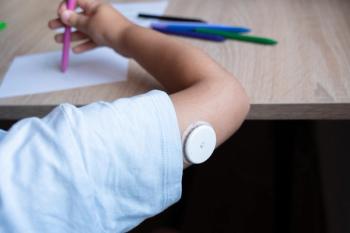
- January/February 2025
- Volume 41
- Issue 1
A green nail after trauma in an 8-year-old boy
His mother reported that the nail had developed a green discoloration and had begun to detach approximately 1 week prior to the visit.
The case
An 8-year-old boy presented to the pediatrician’s office for evaluation of his fingernail. His mother reported that the nail had developed a green discoloration and had begun to detach approximately 1 week prior to the visit. There was no associated pain, swelling, or erythema. One month earlier, the boy’s finger had been slammed in a car door, prompting an x-ray that showed no fractures. The patient is otherwise healthy, plays baseball, and swims daily in the family’s swimming pool. There were no other signs of infection or trauma, and the child had no history of similar occurrences.
Diagnosis:
Green nail syndrome
Etiology and clinical findings
Green nail syndrome, or chloronychia, is due to infection with Pseudomonas aeruginosa, a gram-negative bacterium that forms a distinctive blue-green biofilm on the nail surface. This biofilm results from the production of pyocyanin, a blue-green exopigment unique to P aeruginosa.1 Key predisposing factors include repeated mechanical trauma, prolonged exposure to moist environments or detergents, and underlying nail conditions. While P aeruginosa is not part of the normal skin flora, infection can occur when the nail’s protective barrier is compromised. Green nail syndrome has been observed in all age groups and is associated with occupations or activities involving excessive moisture, such as frequent swimming, dishwashing, or working in wet environments.2 Recently, it has been reported that onychomycosis is frequently associated with green nail syndrome and might be a predisposing factor.3
Clinically, green nail syndrome presents as a painless, greenish-blue or greenish-black discoloration of the affected nail caused by the proliferation of P aeruginosa in the subungual space. Because the discoloration is underneath the nail, it will not disappear with washing or scrubbing. This distinctive hue is typically observed along with other nail abnormalities, most commonly proximal paronychia, which involves inflammation and swelling around the nail fold; and distal onycholysis, where the nail separates from the underlying nail bed.4 The condition is usually confined to a single nail, although nearby nails may also be involved. Striping or longitudinal pigmentation can also develop, with linear discoloration aligning with clinical episodes of infection or trauma.4 In more severe cases, the nail may become thickened, brittle, or dystrophic, with extensive detachment from the nail bed.
The differential diagnosis for nail discoloration includes several key conditions that can be related to trauma, infections, pigmentary disorders, and neoplastic conditions (Table). Subungual hematomas are common in children after a crush injury or other trauma and result from blood accumulation between the nail bed and nail plate.5 The discoloration ranges from reddish to reddish-black, depending on the age of the blood, and the affected nail is typically tender. Dermoscopy may reveal small blood globules, which gradually grow out as the nail heals.
Exposure to hazardous chemicals such as isocyanates without proper barrier protection can also lead to nail discoloration, often characterized by a distinct meniscal border of fluid-solid contact.6
Related: Can you diagnose this boy with painful nodules on his feet?
In addition to Pseudomonas infection in green nail syndrome, other infectious causes of nail discoloration include onychomycosis, a fungal infection marked by yellowish discoloration; subungual hyperkeratosis; and onycholysis. Diagnosis of onychomycosis is confirmed through a positive fungal culture. Paronychia, a bacterial or fungal infection of the nail fold, presents with acute erythema, edema, pain, and tenderness along the lateral or proximal nail fold, usually affecting a single digit.7 Pressure on the nail fold may cause purulent discharge. Notably, these traumatic and infectious conditions frequently coexist with green nail syndrome, adding complexity to the clinical presentation.3,7
Nail discoloration can also arise from various pigmentary disorders. Longitudinal melanonychia appears as brown or black pigmented bands along the length of the nail plate, often affecting multiple nails. While they are frequently benign, evaluation is necessary to rule out malignancy, particularly in cases where a single digit is involved.8 Drug-induced nail pigmentation from medications such as antimalarials, tetracyclines (especially minocycline), or chemotherapy agents can lead to diffuse or localized discoloration, often traceable to the patient’s drug history.8,9 In certain endocrine disorders such as Addison disease, increased melanocyte activity results in diffuse brown pigmentation of the nails with associated skin and mucosal hyperpigmentation. Black or blue-black discoloration of the nails can also be observed in the setting of vitamin B12 deficiency, often accompanied by systemic symptoms of deficiency.10
The most serious condition to consider when evaluating nail discoloration is subungual melanoma, a challenging diagnosis associated with a worse prognosis than melanomas located elsewhere.11 Fortunately, subungual melanoma is a rare cause of brown-black nail pigmentation, with other melanocytic and nonmelanocytic conditions being far more common. It typically presents as a dark black discoloration affecting a single nail.12 Suspicious features include Hutchinson sign (pigment extending from the nail bed to adjacent skin), areas of regression, and irregular dermoscopic patterns such as a brown background of the band, irregular margins, and nonparallel or discontinuous lines.12 If subungual melanoma is suspected, prompt biopsy and urgent dermatology referral are critical.
Green nail syndrome is a clinical diagnosis and additional diagnostic studies are typically unnecessary. For our patient, the diagnosis was confirmed by the very distinct blue-green pigment, absence of pain and exudate, and history of extensive water exposure following trauma. When the diagnosis is uncertain, nail clippings or subungual debris can be sent for Gram stain and culture. However, cultures are often negative because the green discoloration can extend far from the infected site and the biofilm formed in vivo by P aeruginosa makes it difficult to isolate and grow.13 Even with negative cultures, pyocyanin and pyoverdine solubility tests (blue-green and fluorescent yellow-green, respectively) can help differentiate P aeruginosa from Aspergillus or Proteus mirabilis.13 A simple pigment solubility test can be done by placing a nail sample in 1 mL of distilled water, which turns bluish-green within 24 hours if P aeruginosa is present.2 UV or Wood lamp examination may also reveal a yellow-green fluorescence characteristic of Pseudomonas infections.
Treatment and management
Treatment of green nail syndrome has not been extensively studied. Although spontaneous remission is common, management primarily focuses on eradicating P aeruginosa and reducing moisture exposure around the nails.14,15 Topical antibiotics including mupirocin (Bactroban), aminoglycosides, or topical fluoroquinolones can be applied to the nail bed until the infection resolves and can also address coexisting paronychia.2,16
Oral treatment with fluoroquinolone is usually not required and is not recommended as a therapy for children. A critical aspect of management is preventing moisture retention around the nails, which can be achieved by thoroughly drying the nails with a hair dryer after water exposure, such as bathing or swimming. When onychomycosis coexists, antifungal treatments may be combined with antibiotics to address both conditions. Additional interventions such as trimming and debridement of the affected nail may help reduce the bacterial load and improve the effectiveness of treatment.
Patient course
This patient’s pediatrician initially recommended the application of mupirocin ointment a few times daily to the affected nail. Once the diagnosis of green nail syndrome was confirmed, the primary management shifted to keeping the nail as dry as possible. The family would use a hair dryer on the nail after any exposure to water, including swimming and bathing. Over time, the nail continued to detach from the nail bed, but the green and black discoloration progressively improved. There were no further complications, and the nail has continued to show significant healing.
References:
1. Abdelaziz AA, Kamer AMA. Al-Monofy KB, Al-Madboly LA. Pseudomonas aeruginosa’s greenish-blue pigment pyocyanin: its production and biological activities. Microb Cell Fact. 2023;22(1):110. doi:10.1186/s12934-023-02122-1
2. Anderson B, Regula C. Green nail syndrome (GNS, Pseudomonas nail infection, chloronychia, green striped nails, chromonychia). Dermatology Advisor. March 13, 2019. Accessed September 1, 2024. https://www.dermatologyadvisor.com/home/decision-support-in-medicine/dermatology/green-nail-syndrome-gns-pseudomonas-nail-infection-chloronychia-green-striped-nails-chromonychia/
3. Ohn J, Yu DA, Park H, Cho S, Mun JH. Green nail syndrome: analysis of the association with onychomycosis. J Am Acad Dermatol. 2020;83(3):940-942. doi:10.1016/j.jaad.2020.01.040
4. Schwartz RA, Reynoso-Vasquez N, Kapila R. Chloronychia: The Goldman-Fox syndrome - implications for patients and healthcare workers. Indian J Dermatol. 2020;65(1):1-4. doi:10.4103/ijd.IJD_277_19
5. Loewenstein SN, Adkinson JM. Pediatric fingertip injuries. Hand Clin. 2021;37(1):107-116. doi:10.1016/j.hcl.2020.09.009
6. Leung LK, Harding J. A chemical mixer with dark-green nails. BMJ Case Rep. 2015;2015:bcr2014209203. doi:10.1136/bcr-2014-209203.
7. Relhan V, Bansal A. Acute and chronic paronychia revisited: a narrative review. J Cutan Aesthet Surg. 2022;15(1):1-16. doi:10.4103/JCAS.JCAS_30_21
8. Alessandrini A, Dika E, Starace M, Chessa MA, Piraccini BM. Diagnosis of melanonychia. Dermatol Clin. 2021;39(2):255-267. doi:10.1016/j.det.2020.12.004
9. Weinberg LS, Arreola A, Mervak JE. Gray-blue discoloration of the proximal nail beds. JAAD Case Rep. 2023;35:126-128. doi:10.1016/j.jdcr.2023.04.004
10. Faico-Filho KS, Martins RS, Santos CL, Poles WA, de Mello RB, Moura-Faico MM. Total melanonychia of 20 nails as a rare manifestation of vitamin B12 deficiency. JAAD Case Rep. 2020;6(4):372-373. doi:10.1016/j.jdcr.2020.02.014
11. Chakera AH, Quinn MJ, Lo S, et al. Subungual melanoma of the hand. Ann Surg Oncol. 2019;26(4):1035-1043. doi:10.1245/s10434-018-07094-w
12. Piraccini BM, Dika E, Fanti PA. Tips for diagnosis and treatment of nail pigmentation with practical algorithm. Dermatol Clin. 2015;33(2):185-195. doi:10.1016/j.det.2014.12.002
13. Baran R, Richert B. Green nail: etiology and treatment of chloronychia. Hand Surg Rehabil. 2024;43S:101653. doi:10.1016/j.hansur.2024.101653
14. Geizhals S, Lipner SR. Retrospective case series on risk factors, diagnosis and treatment of Pseudomonas aeruginosa nail infections. Am J Clin Dermatol. 2020;21(2):297-302. doi:10.1007/s40257-019-00476-0
15. Spernovasilis N, Psichogiou M, Poulakou G. Skin manifestations of Pseudomonas aeruginosa infections. Curr Opin Infect Dis. 2021;34(2):72-79. doi:10.1097/QCO.0000000000000717
16. Leggit JC. Acute and chronic paronychia. Am Fam Physician. 2017;96(1):44-51.
Articles in this issue
9 months ago
Debunking myths about diet and acneNewsletter
Access practical, evidence-based guidance to support better care for our youngest patients. Join our email list for the latest clinical updates.














